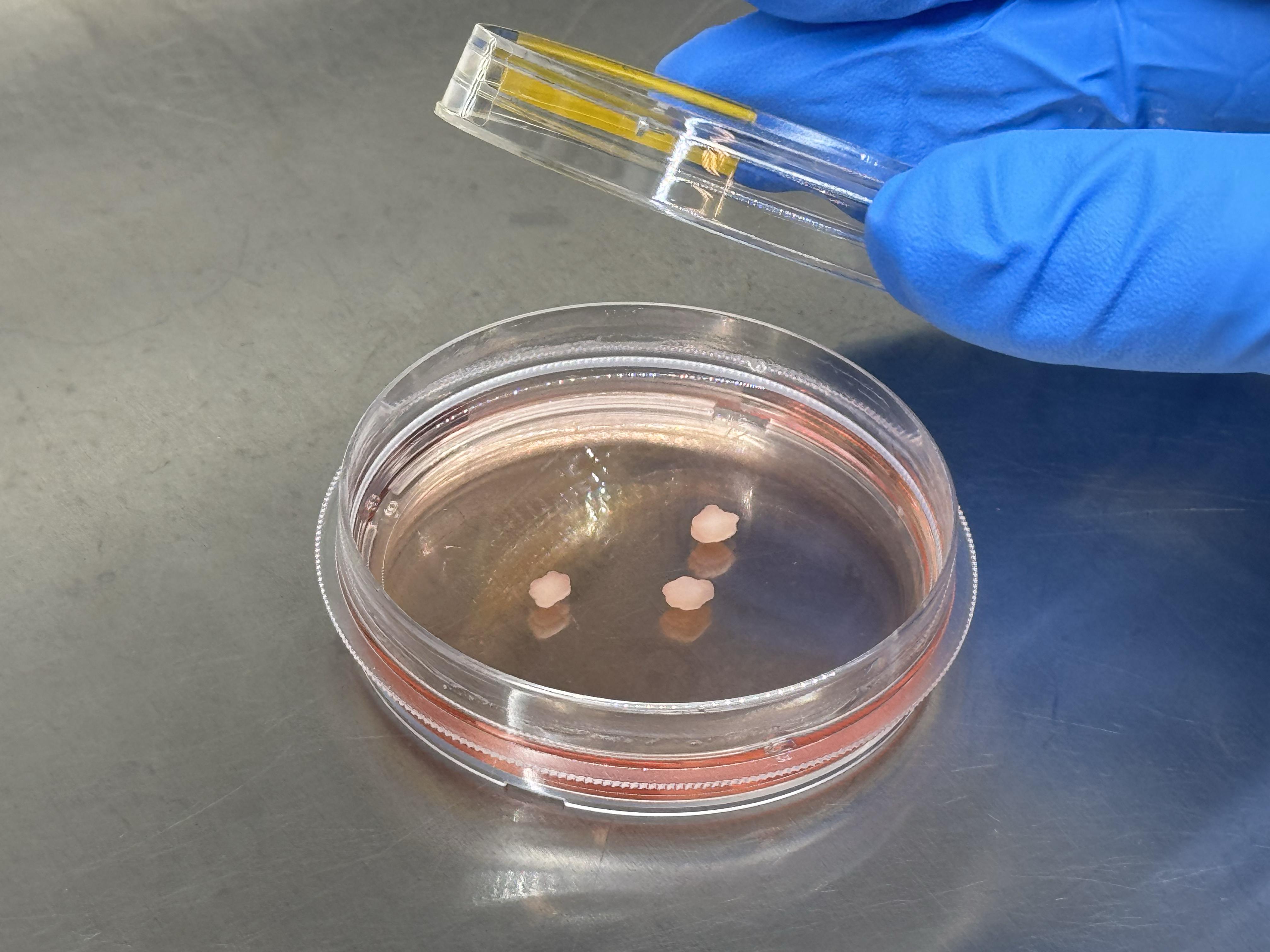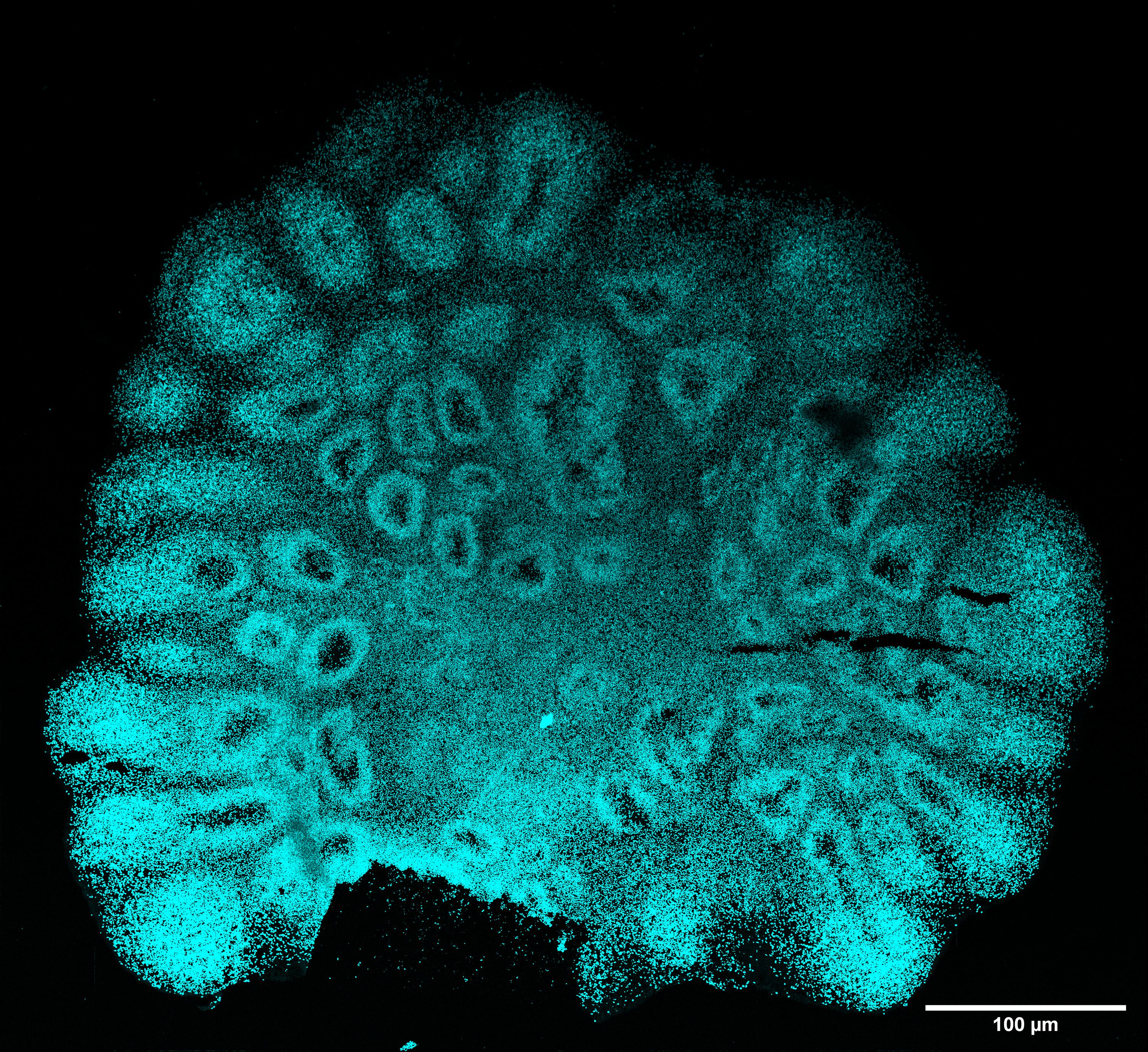
Pipetting brain organoids at Fides Zenk's laboratory - 2025 EPFL/Zenk Lab
Organoids are a promising breakthrough that scientists have been exploring over the past 15 years. These three-dimensional tissue cultures grown from human stem cells stand to revolutionize some aspects of biomedical research, but they won't do away entirely with the need for animal testing.
For Matthias Lütolf, it all started when he attended a talk by Prof. Hans Clevers - a leading figure in molecular genetics and pioneer in organoid research - at EPFL in 2010. Lütolf was a young professor of tissue engineering at the time, and he was "blown away" by the possibility of creating cultures of intestinal epithelium from stem cells. Could these organoids eventually be able to reproduce the basic functions of the human intestine? The potential for biomedical research seemed virtually unlimited, and Lütolf found his calling, joining a corps of organoid researchers that has grown steadily worldwide over the past 15 years.
After spending 18 productive years at EPFL, Lütolf now carries out his research at Roche's headquarters in Basel. In 2022, he co-founded the Roche Institute of Human Biology, located in one of the company's landmark towers. Walking through the labyrinthine halls (not unlike those at EPFL), he points out each of the research labs in turn. Large incubators contain what, to the untrained eye, looks simply like tiny clusters, no larger than a pea, growing inside petri dishes. Then the labels come into view: brain, intestine, liver, kidney, and so forth. Lütolf explains that the clusters are organoids and that the incubators are kept at 37°C - the temperature of the human body - and include stirrers to mimic the function of blood flow.

Numerous opportunities
"There are at least two very promising things about organoids," says Lütolf, who still teaches at EPFL and is involved in projects with two EPFL research groups. "The first is the unique way they can model human biology, since they're made from human stem cells. That opens up numerous opportunities in translational research" - research aimed at translating scientific discoveries into new medical treatments. "The second is they let us directly observe tissue with the same characteristics as that inside the human body and manipulate it with precision, right inside a petri dish. Organoids open the door to more impactful biological research and allow us to model processes that cannot be modeled with conventional in vitro methods." Lütolf's research group, convinced by the potential offered by organoids, even launched an "organoid farm", with Roche's backing. It will feature an automated production line that can fabricate tens of thousands of organoids per batch, resulting in a much cheaper and faster method than the existing long and tedious manual process.
Scientists here and elsewhere in the world are working hard to create organoids that contain all relevant kinds of tissue and can therefore function more like actual organs.
We shouldn't be misled by the term organoid. These are not "mini-organs" with all the same features and functions of regular organs on a reduced scale. For now, organoids have neither blood vessels nor nerves and aren't located in an environment with a working immune system - a point that's crucial for the study of complex diseases. They also don't have many of the cell and tissue types needed for regular organs to function. And perhaps most importantly, they aren't connected to each other.
"If we look at the human intestine, for example, an organoid can replicate only the outer layer - the barrier between it and the rest of the body," says Lütolf. "That's the epithelial tissue we're growing in our lab. But scientists here and elsewhere in the world are working hard to create organoids that contain all relevant kinds of tissue and can therefore function more like actual organs. There's still a lot of work to be done."
A constellation of patient-derived organoids from colorectal cancer tissue illuminates the heterogeneity of the patient population. Like stars, these organoids guide insights about the diverse nature of the disease. More on the image https://t.co/XUKFL0wtfl#TeamIHB#pRED@Rochepic.twitter.com/mGHfuMrLjM
- Institute of Human Biology (@IHB_Research) November 11, 2024
Powerful models
For some research purposes, however, organoids in their current form are mostly sufficient. At EPFL, assistant professor Fides Zenk uses organoids extensively in her work. "Organoids were rising during my postdoc, and we soon saw that they could be powerful models for studying the early-stage development of the human brain, which is one of my main focus areas," she says. Zenk holds the NeuroNA Chair in Epigenomics of Neurodevelopmental Disorders and opened a research lab at Campus Biotech in Geneva in 2023. She uses brain organoids to investigate how epigenetic modulators influence early developmental decisions of brain cells.
"We currently have no way of viewing the initial stages of brain development as they occur inside a human embryo. So organoids give us the perfect model."
The scientists in Zenk's research group, like those working with Lütolf, use adult human induced pluripotent stem cells that are grown in a laboratory and programmed to develop into any type of cell, including neurons. Researchers aggregate the cells into a matrix in order to produce organoids of specific parts of the brain and replicate the initial stages of brain development. "We currently have no way of viewing these stages as they occur inside a human embryo," says Zenk. "So organoids give us the perfect model."
The future of biotechnology
Organoids are not a magic wand that will give scientists a full understanding of human biology and let them develop cures in the lab with no need for animal testing and no ethical considerations. But they do open up new avenues of research in biotechnology. Many EPFL research groups are working in this area, such as the one led by assistant professor Wouter Karthaus. His team is studying the biology of prostate and mammary gland cancer through an approach that combines organoids with testing on mice and methods from genomics.
EPFL's Center of PhenoGenomics, which manages the School's animal facilities, also supports organoid-based research. It opened the Stem Cell and Organoid Laboratory in 2024 to give all EPFL research groups a shared facility with extensive support. In addition, the Bioengineering & Organoids Technology platform at the Agora cancer research center, located near Lausanne University Hospital, provides organoid facilities for research groups from EPFL, the University of Lausanne and the University of Geneva. "We support scientists in their experiments and help them explore methods that may be new to them, in order to lower the barrier to entry for the use of organoids and complicated in vitro models," says Gaspard Pardon, who heads the platform.
Animal testing still necessary
"We can question the relevance of the model, and especially its reproducibility, but organoids are already providing solutions," says Pardon. "Being able to examine human biology directly is a big advantage. For instance, many drugs that work on animals don't work on humans because our biology is different. That said, organoids aren't yet at a stage where they can replace animal testing, since scientists need animals to study systemic factors."

Research with animals such as mice and fish will still be important for both basic and applied research, particularly to examine complex biological processes. Despite its limitations, animal research is still the best alternative to testing directly on humans. "I'm reluctant to give a timeline for when organoids will be able to replace animal research," says Lütolf. "Organoids don't let us model the biology of entire organisms. Some questions can only be answered by examining an actual organism - an animal. It will take time before more realistic models are developed that will mark a major step towards replacement."
"We shouldn't forget that organoids are possible thanks only to the massive amount of research that came before," says Zenk. "Many of the questions and concepts we're studying in developmental biology were first explored in flies and mice, for example. These types of models can't be replaced so easily." Her research group may eventually use mice models in addition to organoids to recapitulate longer neural development stages that occur after birth.






